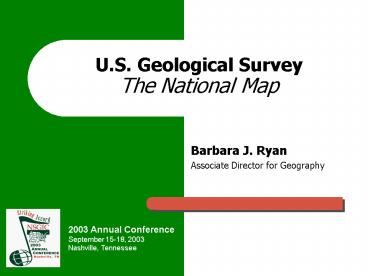U.S. Geological Survey The National Map - PowerPoint PPT Presentation
1 / 10
Title:
U.S. Geological Survey The National Map
Description:
... established or enhanced in AR, AZ, CA, DE, HI, ID, KS, LA, MT, TX, ... Leverage grant opportunities of The National Map, FGDC, and Geospatial One-Stop. ... – PowerPoint PPT presentation
Number of Views:59
Avg rating:3.0/5.0
Title: U.S. Geological Survey The National Map
1
U.S. Geological SurveyThe National Map
- Barbara J. Ryan
- Associate Director for Geography
2
What are the highlight achievements during the
last six months?
- Geospatial One-Stop linkage.
- Catalog-based viewer for The National Map.
- High-resolution imagery for 46 urban areas to
support homeland security / emergency management
needs. - Partnership presence established or enhanced in
AR, AZ, CA, DE, HI, ID, KS, LA, MT, TX, UT, WA. - Cost-benefits analysis for The National Map.
3
The National Map High-resolution Imagery
Status 133 Urban Areas Orthoimagery
collected (46 cities) Planned or in work
4
The National Map Cost-Benefits Analysis
5
What are the milestone achievements for the next
six months?
- Incorporate State requirements and pilot project
lessons learned into The National Map planning. - Formalize MOUs with NSGIC, NACo, other groups.
- Leverage grant opportunities of The National Map,
FGDC, and Geospatial One-Stop. - Consolidate theme-based portals into an enhanced,
multi-service Web viewer. - Effect moves / staff transfers to AL, GA, New
England, MI, PA, and SC.
6
http//nationalmap.usgs.gov
The National Map Web Viewer
- Enhanced viewer will
- Provide a single, multi-service Web viewer.
- Integrate content from diverse data sources.
- Manage the network of partner data and Web
services. - Facilitate data viewing and downloading.
- Allow user to generate graphics from the data.
7
How does this program coordinate / interact with
other Federal programs?
- Standards and data access (FGDC, Geospatial
One-Stop). - High-resolution imagery and critical
infrastructure data (NIMA, DHS, NORTHCOM). - Roads and boundary data (Census, DOT).
- Orthoimagery (USDA, BLM, EPA, FEMA).
- Hydrography (EPA, USFS).
- Elevation (NDEP) data (BLM, COE, FEMA, NOAA,
NRCS, NIMA, NASA, USFS). - Land cover (NOAA, EPA, USFS, NASA).
8
What is the role of States in your program?
- Key source for requirements for The National Map.
- Partners to help build and maintain The National
Map. - Linkage between Federal agencies and local
government for coordination. - Linkage with state legislatures and policy /
program executives for GIS activities and data
partnerships.
9
How can States benefit from your program?
- Access to seamless imagery, vector, and thematic
data in the public domain. - Access to diverse geospatial data sources through
links to partner Web services. - Leverage limited State resources with Federal
investments in geospatial data. - Partnership opportunities for technical
development, data integration, and applications
research.
10
Contact Information Regional Geographers
- Eastern
- Pamela R. Malam
- E pmalam_at_usgs.gov
- P 703-648-7414
- Central
- Max M. Ethridge
- E methridge_at_usgs.gov
- P 573-308-3800
- Western
- Alan M. Mikuni
- E amikuni_at_usgs.gov
- P 650-329-4254































